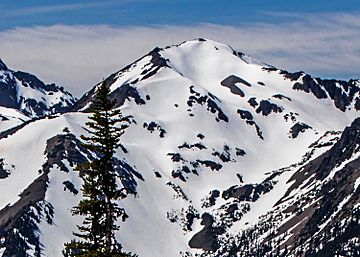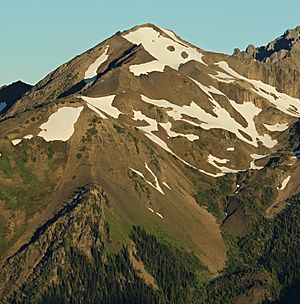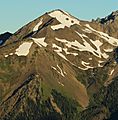Mount Fricaba facts for kids
Quick facts for kids Mount Fricaba |
|
|---|---|

Mount Fricaba, east aspect
|
|
| Highest point | |
| Elevation | 7,139 ft (2,176 m) |
| Prominence | 539 ft (164 m) |
| Geography | |
| Parent range | Olympic Mountains |
| Topo map | USGS Mount Deception |
| Climbing | |
| First ascent | 1957 by Don Bechlem, Jack Newman |
| Easiest route | Scrambling class 2 via Deception Basin |
Mount Fricaba is a tall mountain in the Olympic Mountains of Washington state. It stands 7,139 feet (2,176 m) high and has two main tops, like a "double summit." This mountain is special because it sits right on the edge of Olympic National Park and the Buckhorn Wilderness. It's actually the highest point in the Buckhorn Wilderness and also in the Olympic National Forest.
Water from Mount Fricaba flows in different directions. Some water goes east into the Dungeness River, while other water flows west into Deception Creek, which then joins the Dosewallips River. The mountain got its official name in 1961. People from a climbing group called The Mountaineers had been using the name since 1907. The name was also in a climbing guide written by Fred Beckey in 1949. The first time anyone climbed to the top of Mount Fricaba was in 1957. Two climbers named Don Bechlem and Jack Newman made that first successful climb. If you want to climb this mountain, the best time to go is usually between June and September, when the weather is nicer.
Weather at Mount Fricaba
Mount Fricaba is located in a marine west coast climate zone. This means it gets a lot of weather from the Pacific Ocean. Most of the weather systems, like clouds and storms, travel from the Pacific Ocean towards the Olympic Mountains.
When these weather systems hit the tall Olympic peaks, they are forced to rise. As the air goes higher, it cools down and drops its moisture. This causes a lot of rain or snow to fall on the mountains. Because of this, the Olympic Mountains get a lot of precipitation, especially during winter. In winter, it's often cloudy. But in summer, high-pressure systems over the Pacific Ocean usually bring clear skies. This is why July through September are the best months to visit Mount Fricaba for climbing.
How Mount Fricaba Formed
The rocks that make up the Olympic Mountains, including Mount Fricaba, were formed from material that was pushed up from the ocean floor. These rocks are mostly Eocene sandstone, a type of rock made from sand, and basalt, which is a volcanic rock.
Over millions of years, during the Pleistocene era (also known as the Ice Age), glaciers played a huge role in shaping these mountains. These giant ice sheets moved forward and backward many times. As they moved, they carved out valleys and peaks, giving the Olympic Mountains their unique shape.
Images for kids
-
Mount Mystery and Fricaba (right) seen from Pacific Northwest National Scenic Trail









